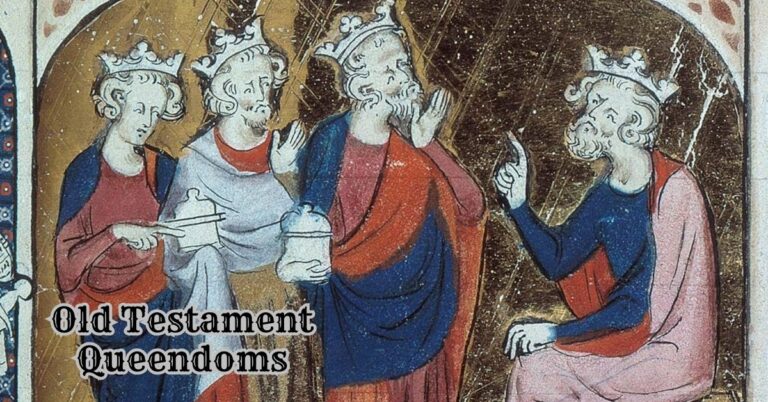Introduction
The Old Testament is a rich tapestry of stories, teachings, and historical accounts that have shaped religious and cultural traditions for millennia. Among the many intriguing aspects of the Old Testament are the queendoms and the powerful women who ruled them. These queens played pivotal roles in the biblical narrative, influencing political, religious, and cultural landscapes. This article delves into the queendoms of the Old Testament, exploring their significance and the lasting legacy of these remarkable women.
Understanding Queendoms in the Old Testament
Definition and Significance
Queendoms in the Old Testament refer to territories or regions ruled by a queen, either as a sole ruler or alongside a king. These queendoms were significant for their political influence, cultural impact, and the roles their queens played in shaping historical events.
Roles of Queens in Ancient Times
Queens in the Old Testament era were often influential political figures, spiritual leaders, and cultural icons. They could act as advisors, mediators, and sometimes even as military leaders. Their influence extended beyond their queendoms, affecting broader regional politics and inter-kingdom relations.
Famous Queens of the Old Testament
Queen Esther
Queen Esther is one of the most celebrated figures in the Old Testament. Her story, found in the Book of Esther, is a tale of courage and faith. As a Jewish queen of the Persian King Ahasuerus, Esther risked her life to save her people from a planned massacre, demonstrating immense bravery and devotion.
Queen Jezebel
Queen Jezebel, wife of King Ahab of Israel, is a controversial figure known for her strong-willed nature and political savvy. Her story, recounted in the Books of Kings, is marked by her support of the worship of Baal, which led to significant conflict with the prophet Elijah and the Israelite religious establishment.
Queen of Sheba
The Queen of Sheba is renowned for her visit to King Solomon, as described in the Books of Kings and Chronicles. Her journey to Jerusalem to test Solomon’s wisdom with difficult questions highlights her as a figure of immense wealth, intelligence, and curiosity.
Queen Esther: A Symbol of Courage and Faith
Background and Story
Esther, an orphan raised by her cousin Mordecai, became the queen of Persia through her beauty and religious texts, influencing modern culture and literature. Contemporary writers, artists, and filmmakers often draw inspiration from the powerful narratives of these queens, highlighting their enduring relevance and the timeless lessons they offer.
Common Misconceptions About Queendoms
Clarifying Historical Inaccuracies
One common misconception is that queens in the Old Testament were merely ornamental figures with little real power. In reality, many of these queens wielded significant influence over political and religious affairs, often playing crucial roles in the governance and direction of their societies.
Understanding the True Roles and Influences
Another misconception is that the impact of these queens was limited to their immediate surroundings. However, the reach of their influence often extended far beyond their own realms, affecting neighboring kingdoms and even shaping broader regional dynamics.
Conclusion
The queendoms of the Old Testament offer a fascinating glimpse into the lives and legacies of some of the most influential women in biblical history. These queens were not just passive figures but active leaders who shaped the course of events through their wisdom, courage, and determination. By understanding their stories, we can gain valuable insights into the complexities of leadership, the importance of faith and morality, and the enduring impact of their legacies on both ancient and modern cultures. Embracing the lessons from these powerful queens can inspire us to lead with integrity, face challenges with resilience, and pursue our higher purpose with unwavering dedication.
FAQs
- Who was the most influential queen in the Old Testament?
- While opinions may vary, Queen Esther is often regarded as one of the most influential queens due to her role in saving the Jewish people from annihilation.
- What were the primary responsibilities of queens in the Old Testament?
- Queens were often responsible for advising the king, influencing political decisions, supporting religious practices, and fostering cultural development within their realms.
- Did queens in the Old Testament have any military roles?
- While not common, some queens, like Jezebel, had significant influence over military decisions, either directly or through their influence over their husbands.
- How did the Queen of Sheba’s visit impact King Solomon’s reign?
- The Queen of Sheba’s visit highlighted Solomon’s wisdom and wealth, strengthening his reputation and enhancing diplomatic relations between their two kingdoms.
- Are the stories of Old Testament queens still relevant today?
- Absolutely. The stories of Old Testament queens offer timeless lessons in leadership, courage, faith, and the complexities of power, making them relevant to both historical and modern contexts.

